- drach09's home page
- Posts
- 2022
- 2020
- June (1)
- 2019
- 2018
- 2017
- 2016
- 2015
- 2014
- December (13)
- November (2)
- October (5)
- September (2)
- August (8)
- July (9)
- June (7)
- May (5)
- April (4)
- March (4)
- February (1)
- January (2)
- 2013
- December (2)
- November (8)
- October (5)
- September (12)
- August (5)
- July (2)
- June (3)
- May (4)
- April (8)
- March (10)
- February (9)
- January (11)
- 2012
- 2011
- October (1)
- My blog
- Post new blog entry
- All blogs
Run-11 Transverse Jets: First Look at Collins vs. Jet Momentum Fraction (Full Statistics)
Following up on a previous update, I now show the sate of the Collins analysis after integrating the full statistics. As before, this should in no way be considered final. Very few cuts have been implemented at this point, and hopefully this analysis will motivate a sensible set.
As before, each plot is fitted with a constant. For negative xF and for p0 distributions, this is a sensible expectation. One hopes to see a signal for positive xF, and comparing to a constant may illuminate such a variation.
NOTE: Asymmetries are not corrected for polarization and error bars are statistical only.
Figure 1: Angular Coverage

It is worth examining the angular coverage of φS vs. φS-φh. One can see the coverage is rather similar to what one sees for the Collins-like angle.
Hemisphere Dependence
One useful check is to examine the asymmetries in the two hemispheres. All things being equal, the answers should be the same. However, I have not implemented a fiducial volume cut (e.g. |η| < 1), so the acceptance is different for the two hemispheres. Likely, I will need to implement such a cut in the near future.
Figure 2: Asymmetry (π+)
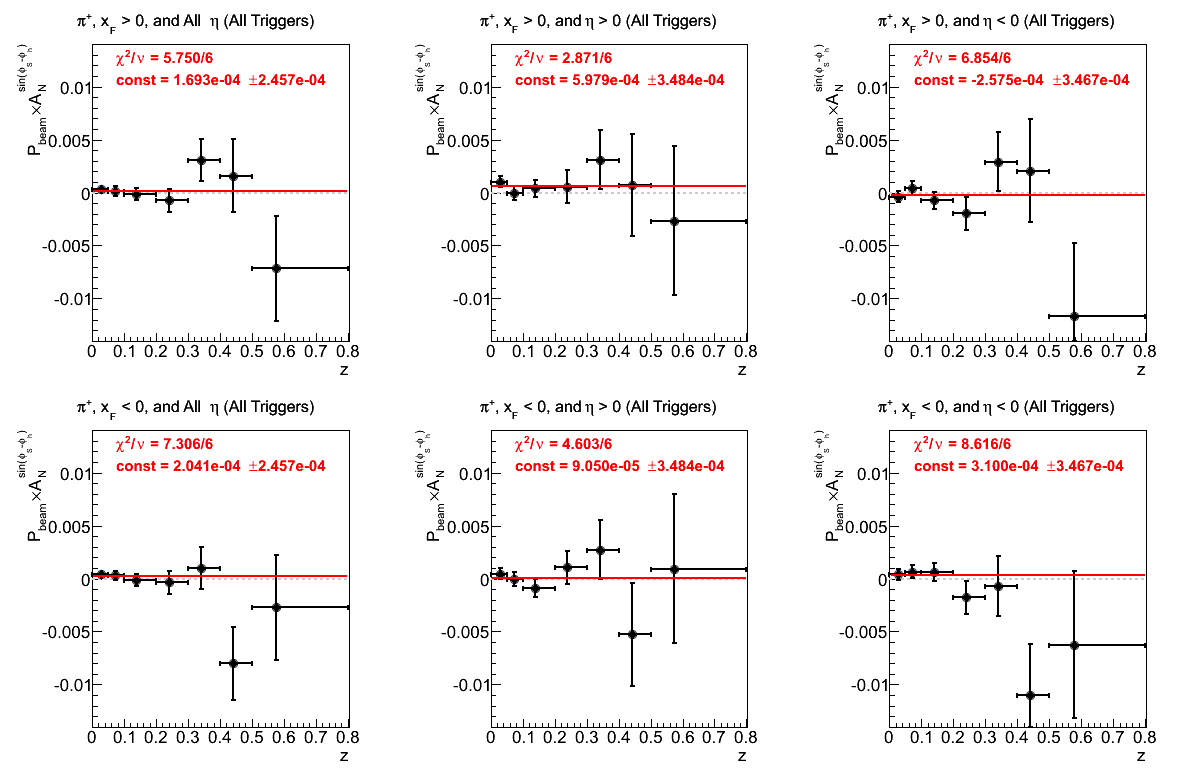
The constant fits for both negative and positive xF are consistent with zero. For positive xF and η > 0, 5 of 7 points appear above the horizontal. However, the offset is not terribly significant (1.72σ), nor is the effect reproduced in η < 0.
Figure 3: Asymmetry (π-)
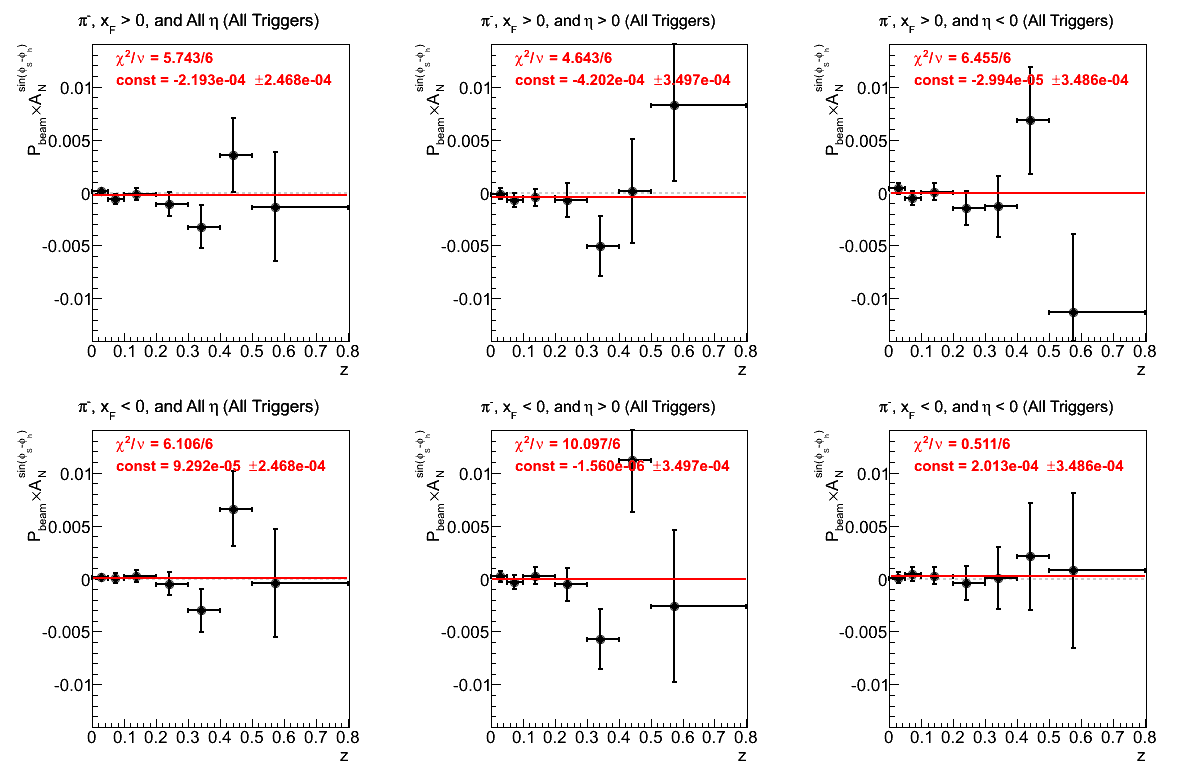
As in Fig. 3, the fits for both negative and positive xF are consistent with zero. Again, with η > 0, there appears to be a hint of a negative effect, however, the statistical signficance is quite small (1.2σ). It is also not reproduced in η < 0. The fit for negative xF and η > 0 is not good at all. We could, again, be seeing systematic effects from pusing the edges of detector acceptance or trigger thresholds. It will be important to review a set of appropriate cuts.
Figure 4: p0 from Fit (π+)
.png)
One finds fits consistent with zero for positive and negative xF. However, for negative xF, there appears to be a fair amount of structure in both hemispheres. Something similar was observed for Collins-like, perhaps, suggesting systematic effects. On the other hand, when broken down into hemispheres, the constant fit is quite reasonable.
Figure 5: p0 from Fit (π-)
.png)
The fits for positive xF are quite reasonable. While the fits for negative xF are also consistent with zero the fit for η > 0 is not good at all.
Trigger Dependence
It is also useful to examine the calculations for the different triggers. One may expect consistent answers in overlap regions. Wide variations may signal systematic effects.
xF > 0
Figure 6: Asymmetry (π+)
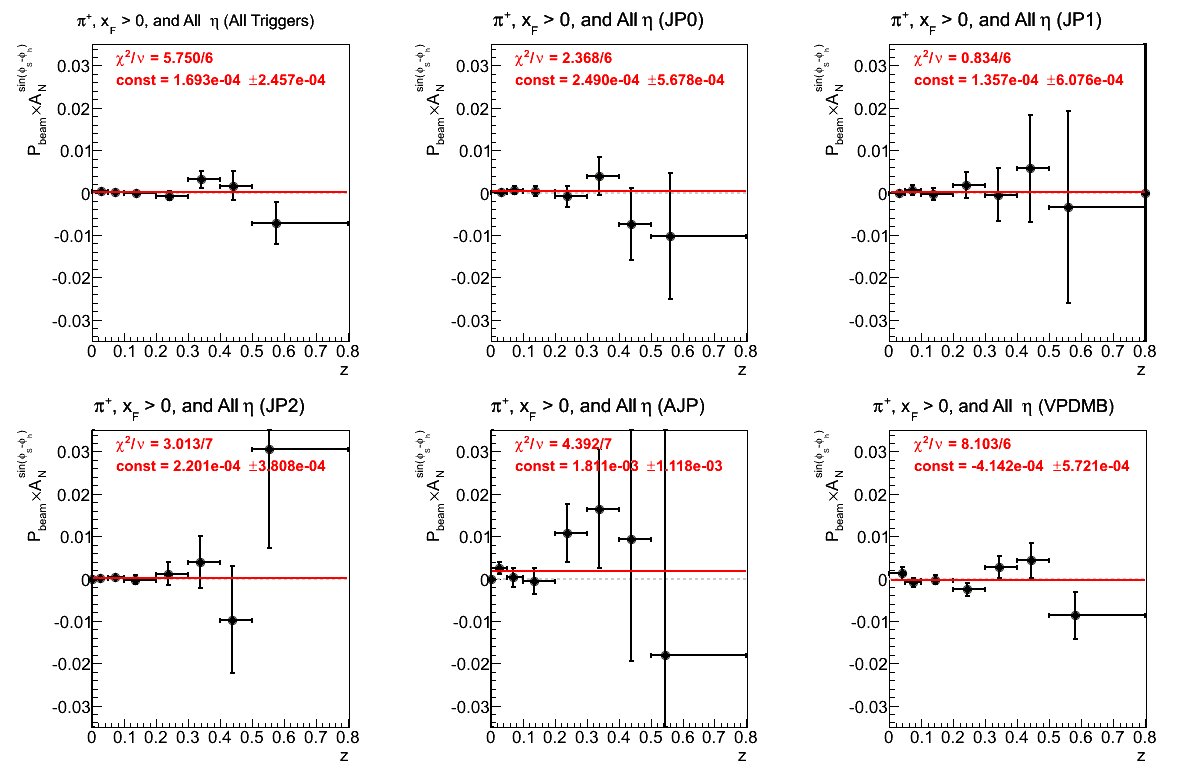
In general, the fits are sensible across the various trigger contributions. The fit for JP1 is ridiculous. The fit for VPDMB is not great, but by no means a show-stopper.
Figure 7: Asymmetry (π-)
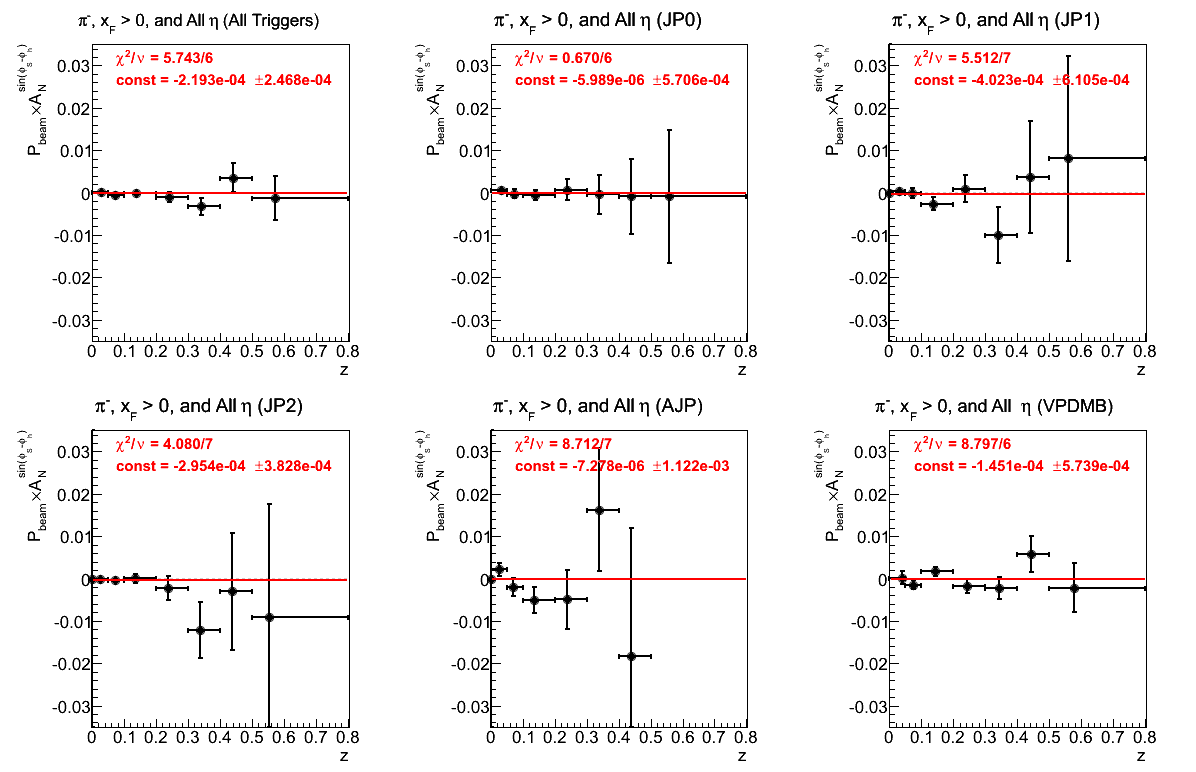
While, the fits are across-the-board consistent with zero, they also appear to be systematically below the horizontal. Again, the fit for VPDMB--and, here also, AJP--are not great, but not inconceivable.
Figure 8: p0 (π+)
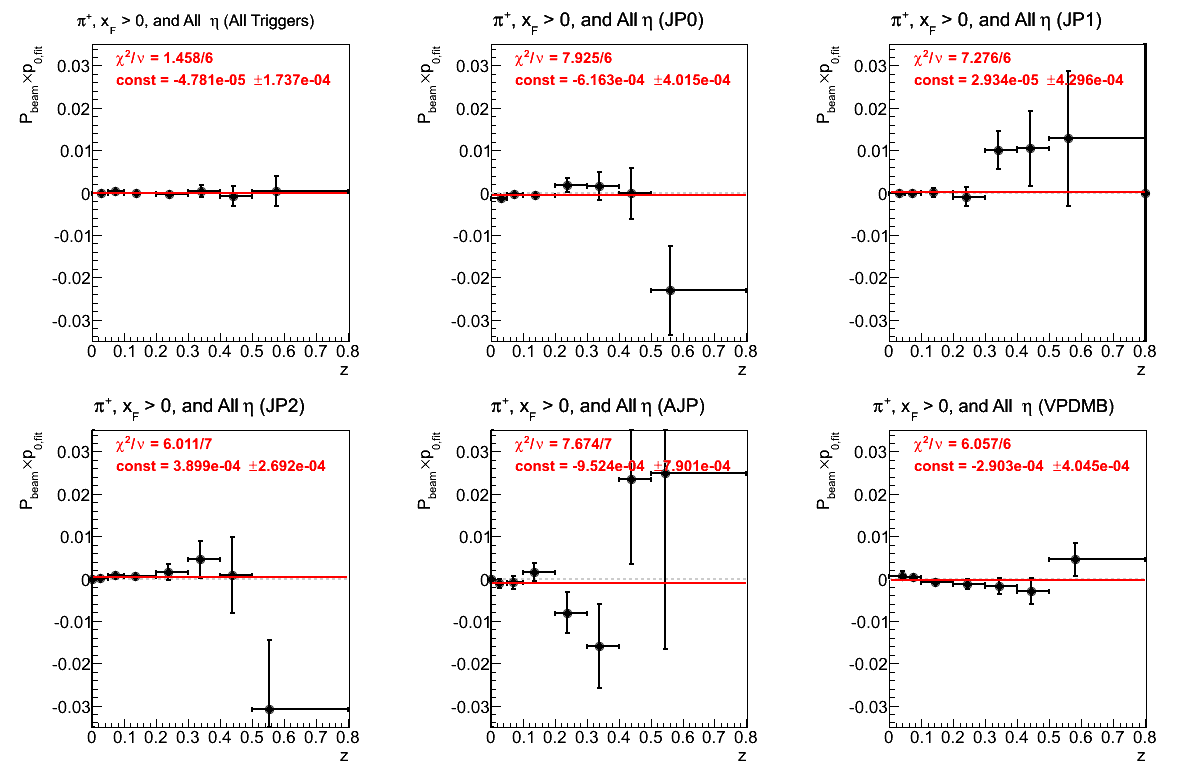
The fits appear to be conistent with zero across the various trigger contributions. The fit quality is not great when broken down into the various contributions but perhaps not alarming.
Figure 9: p0 (π-)
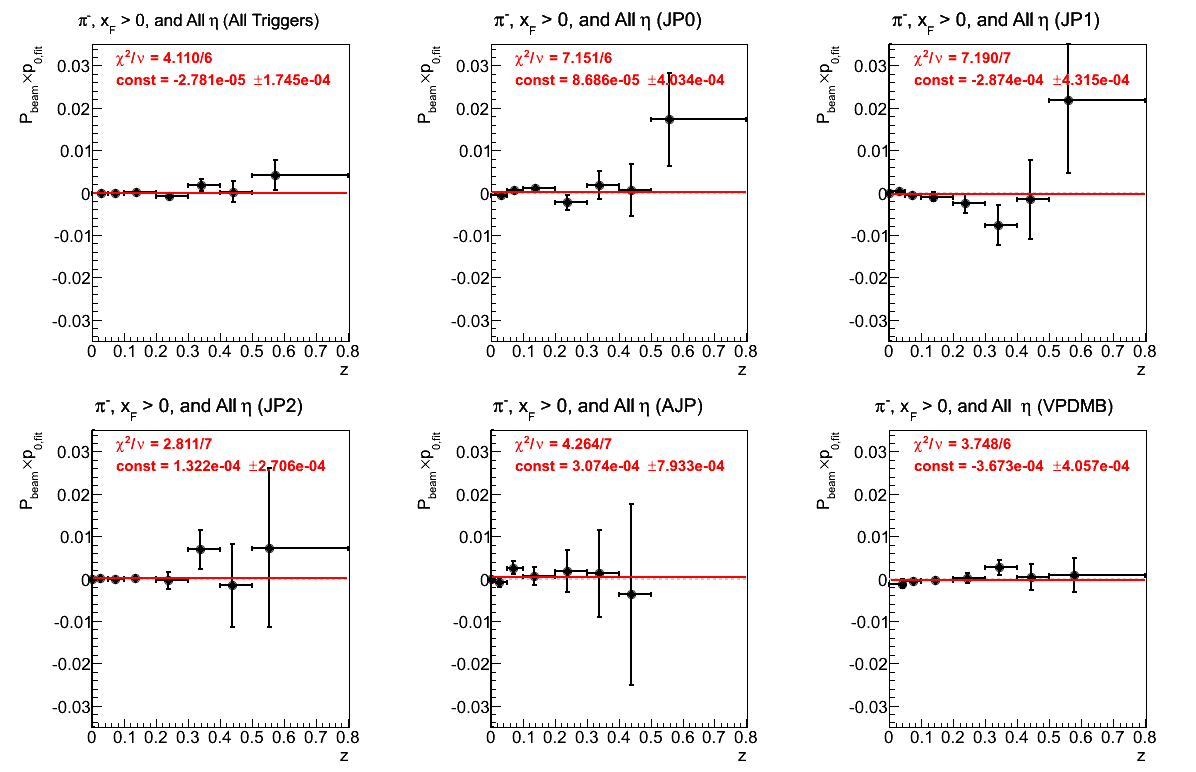
The fits for π- are a bit more well behaved.
xF < 0
Figure 10: Asymmetry (π+)
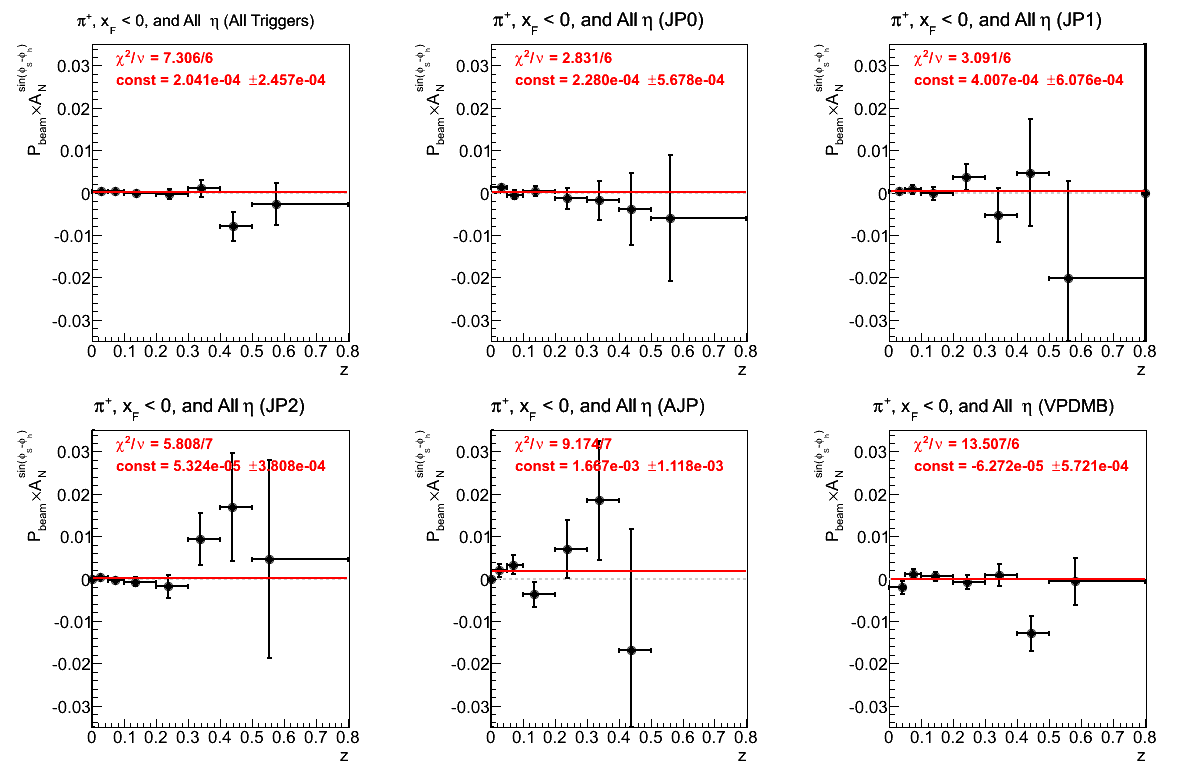
In general things seem as expected. However, the fit for VPDMB is terrible.
Figure 11: Asymmetry (π-)
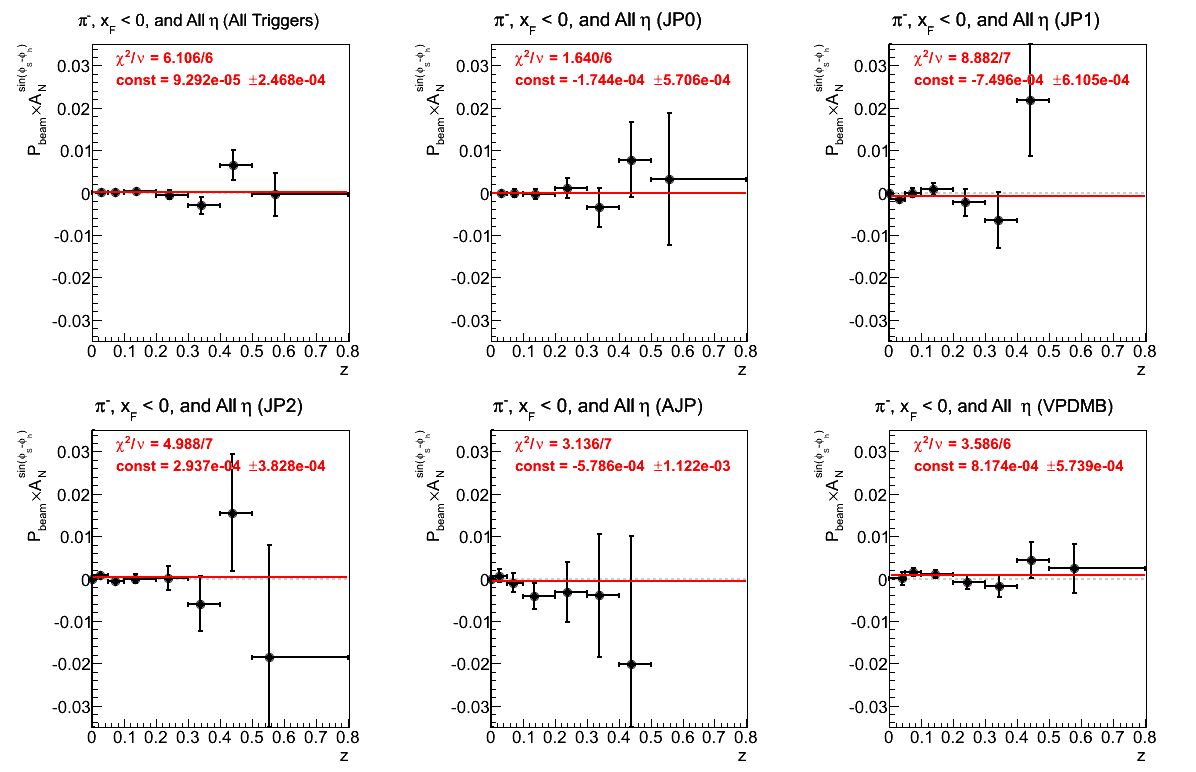
Once again, the π- distributions are more well behaved than π+.
Figure 12: p0 (π+)
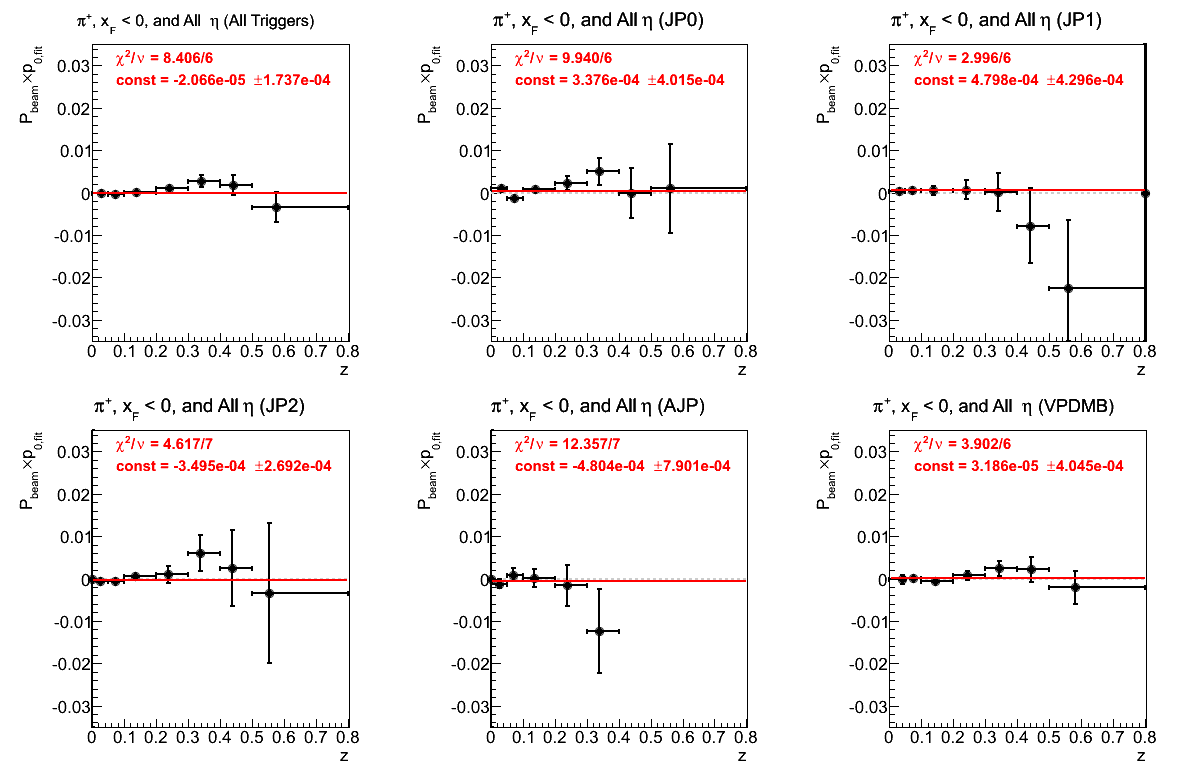
The fits for JP0 and AJP are not very good. Otherwise, the the fits seem reasonable, with slight offsets in JP1 and JP2.
Figure 13: p0 (π-)
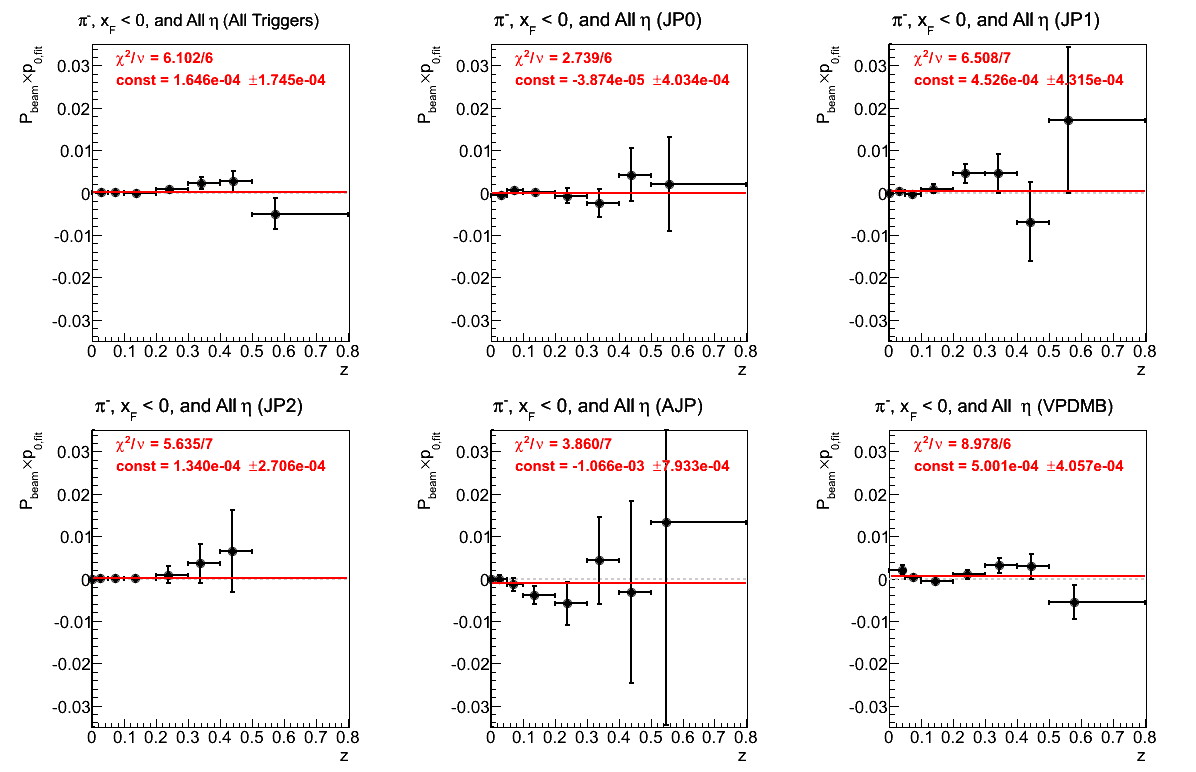
Again, the fit for VPDMB is not great. Otherwise, the fits are not terribly frightening.
Further Statistical Cross-checks
Figure 14: χ2-Distribution for Collins-like Fits
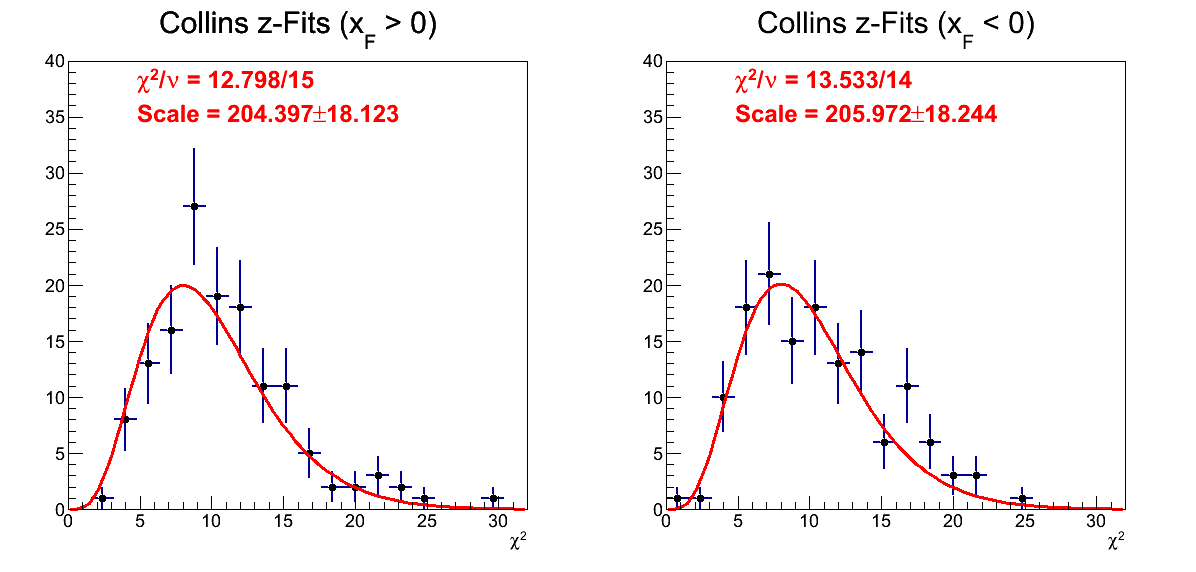
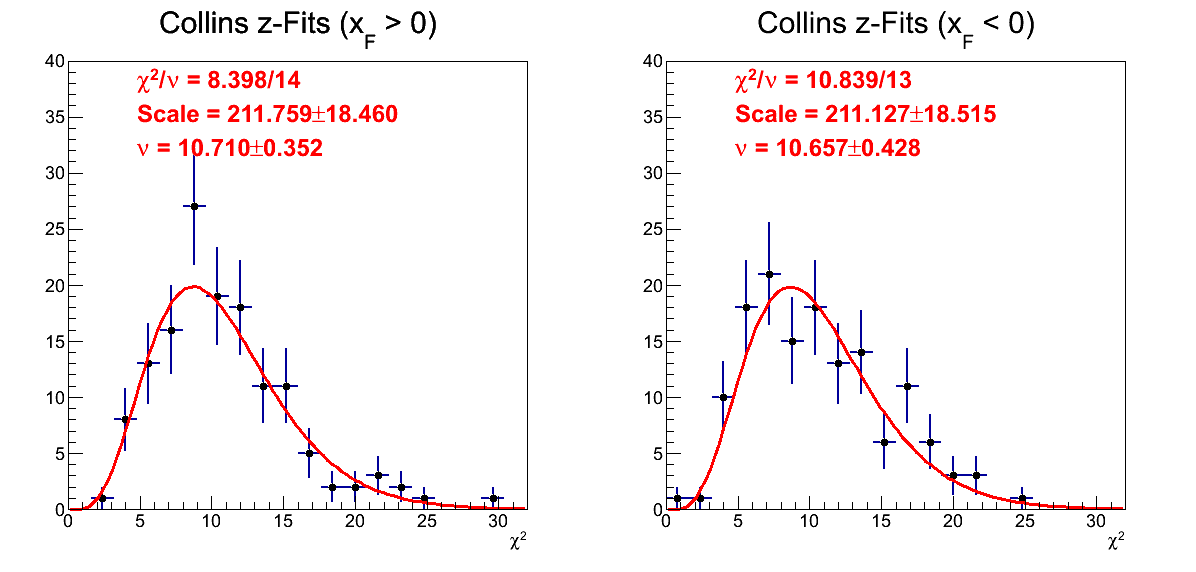
Figure 14 shows the χ2 distribution for the Collins fits (p0+p1×sin(φS-φh)). In red is plotted the expected distribution. On top, the distribution is forced to have ν = 10; and the agreement with expectation is quite good. On bottom, the fit allows ν to float. The fits are of fine quality, and ν is found to be close to the expected value (2.02σ for positive xF and 1.54σ for negative xF).
Distribution of Constant Fits
Figure 15: Asymmetry Fits

In Fig. 15 I show the distribution of constant fits to the asymmetries weighting the entries by 1/uncertainty. There simply are not many fits, thus, it is difficult to glean much information. The distributions are fit with a Gaussian. The fits are not completely crazy. owever, the mean for negative xF is significantly offset from zero.
Figure 16: p0 Fits
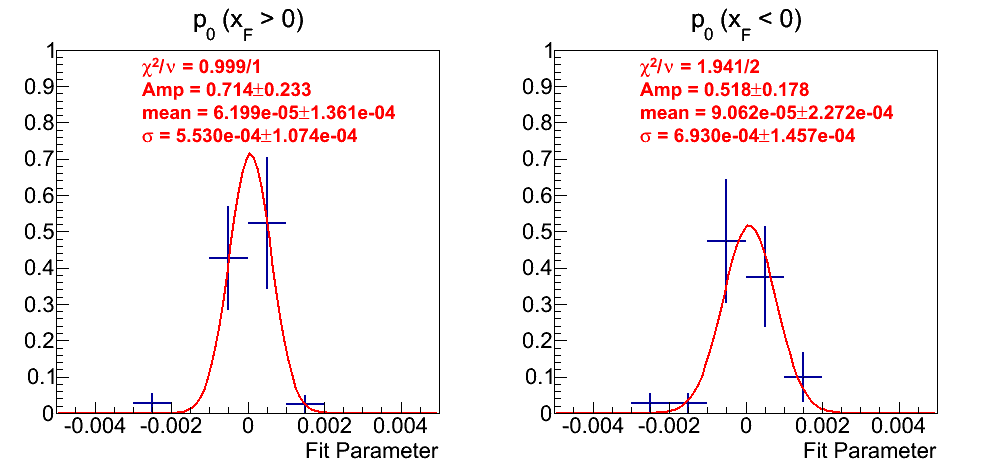
In Fig. 16, I show the weighted distribution for fits to the p0's. Again, there are not many fits from which to draw, but the distribution is quite nice. The fits appear quite Gaussian with means consistent with zero and similar widths.
Reduced χ2 of Constant Fits
With such a low number of fits with varying degrees of freedom, it is impossible to perform a χ2 study of the constant fits. However, we can examine the reduced χ2's for some information.
Figure 17: Asymmetry Fits
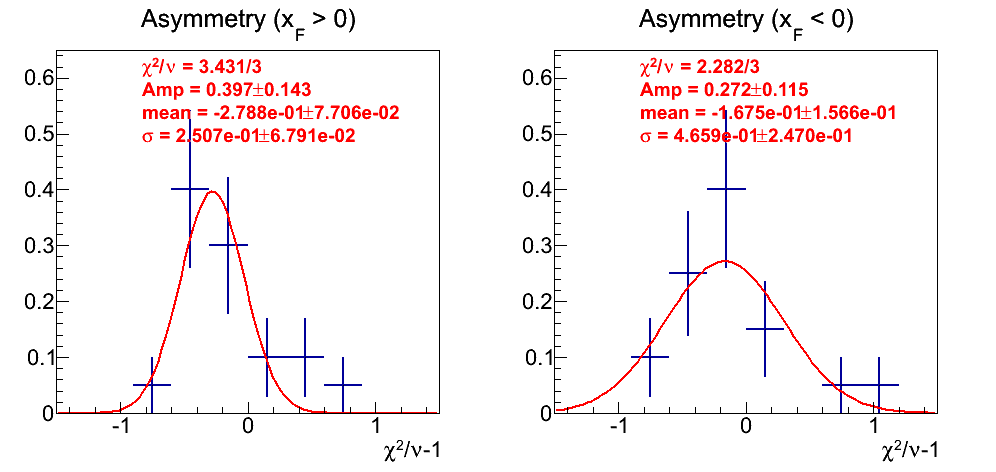
The asymmetry fits seem shifted negatively. Of course, the uncertainties on the mean and width are sizable.
Figure 18: p0 Fits
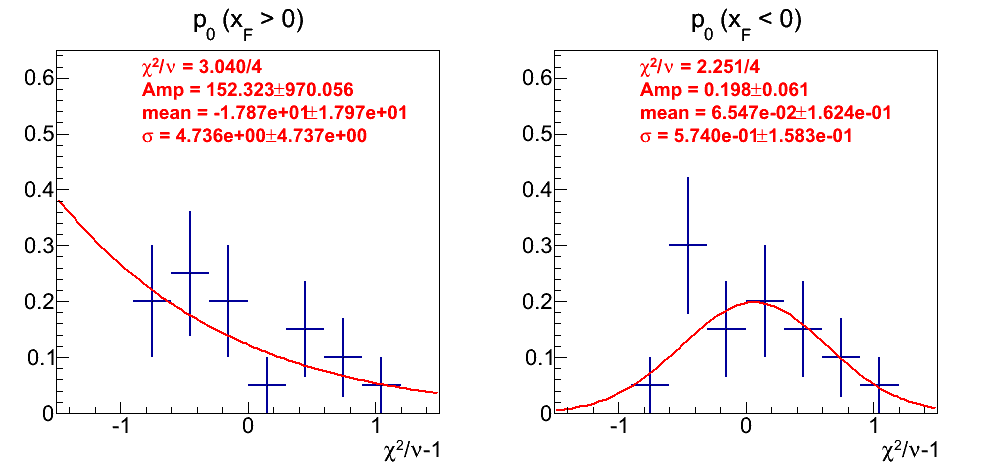
Positive xF is fairly scattered, and the fit is meaningless. For negative xF, the distribution is not bad.
η Dependence
The distributions in Fig. 15- Fig. 18 are taken from fits to the various triggers in different hemispheres. In Fig. 19-Fig. 28 I show the results of these fits.
π+
Figure 19: JP0 Triggers
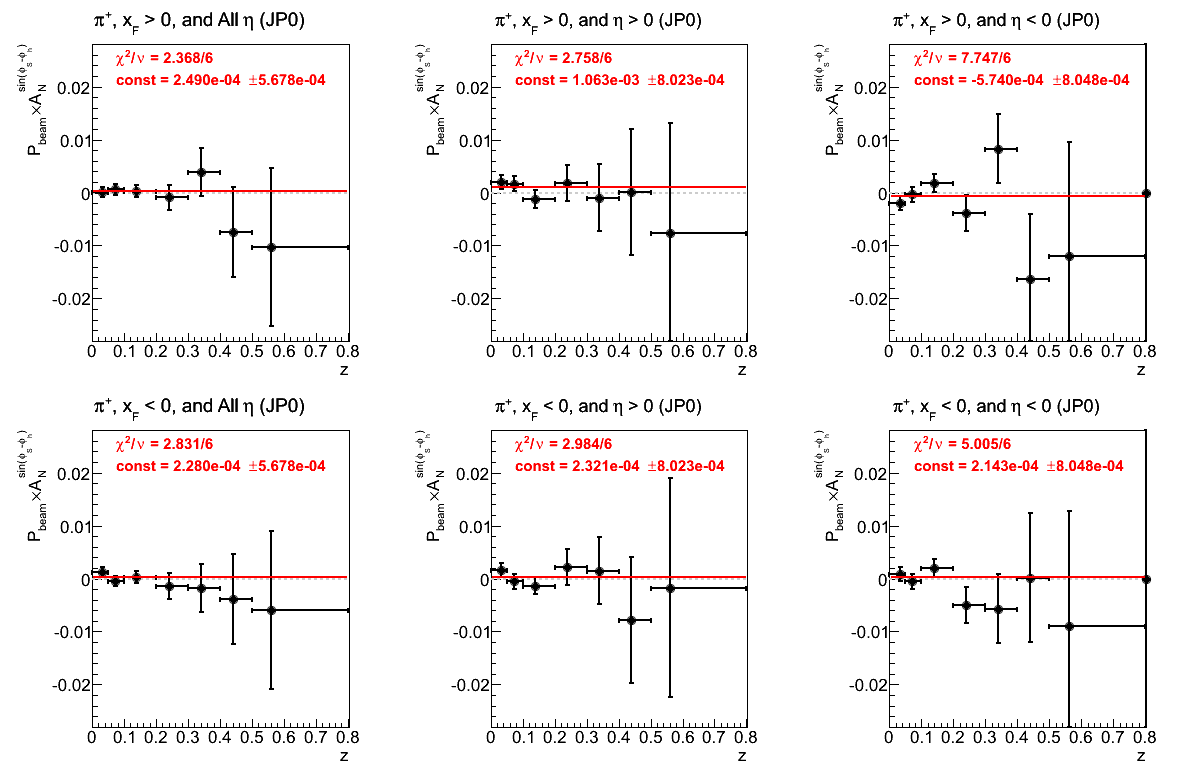
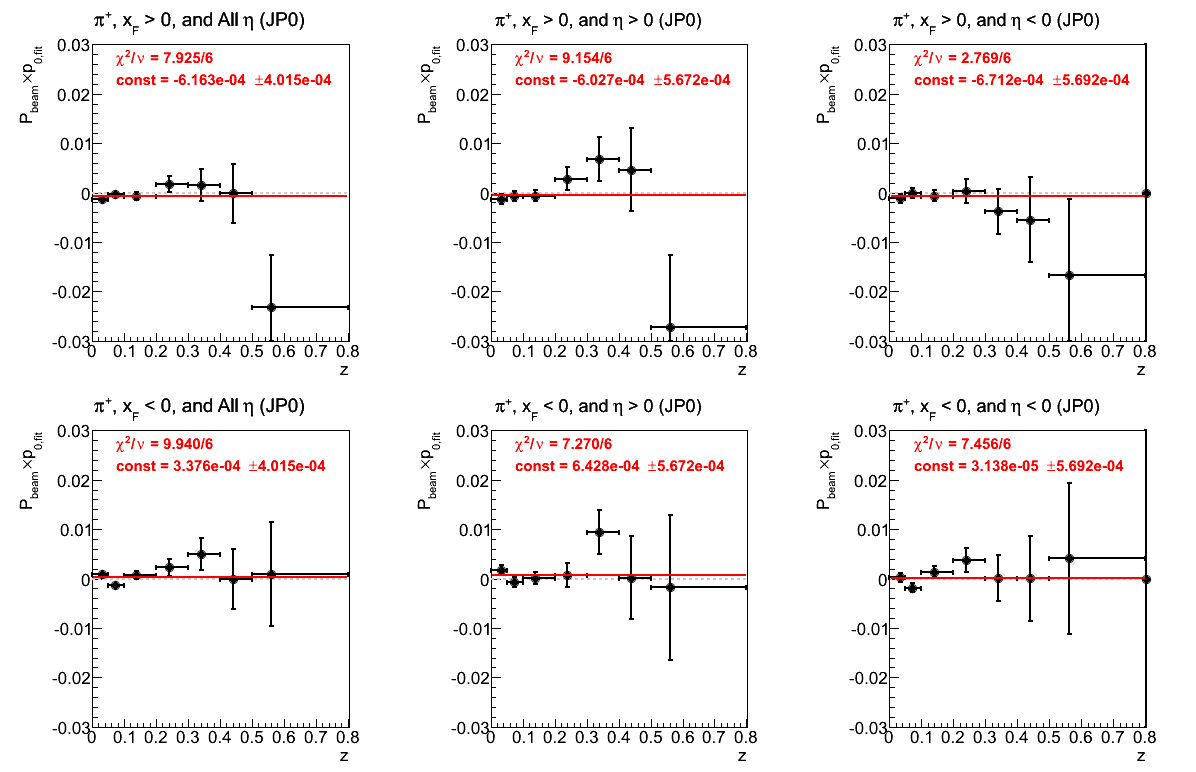
Figure 20: JP1 Triggers
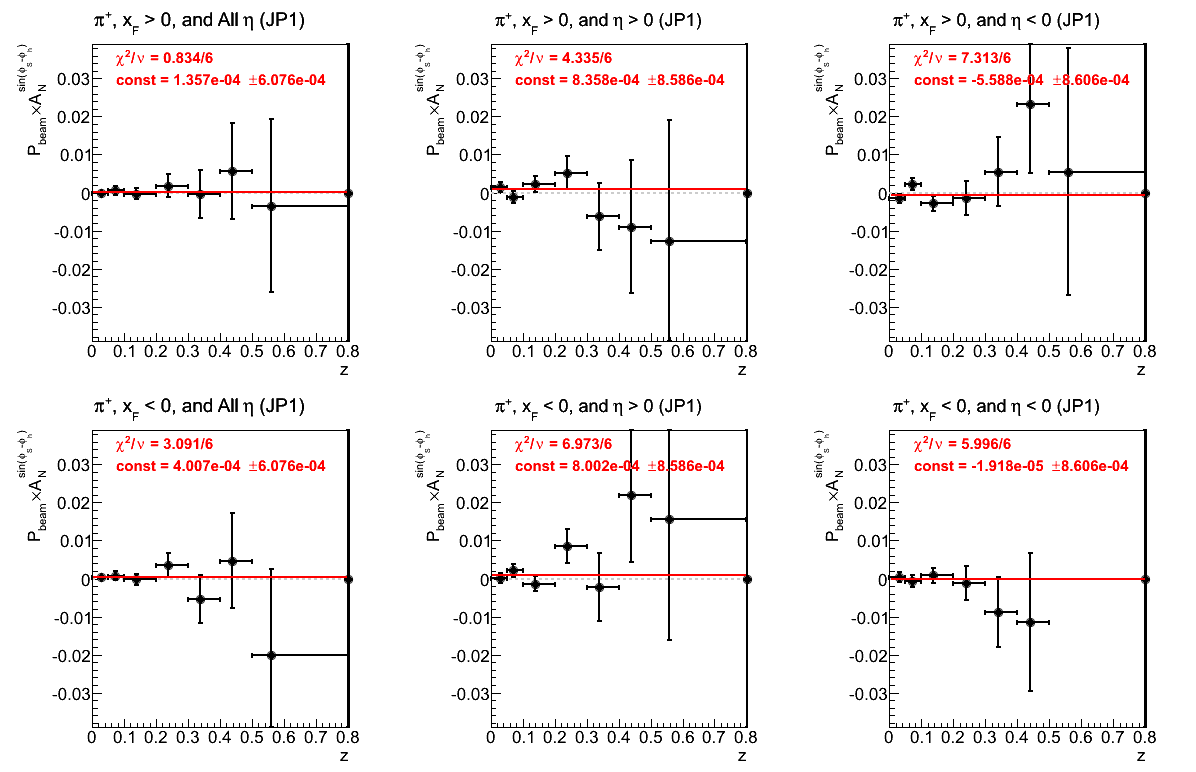
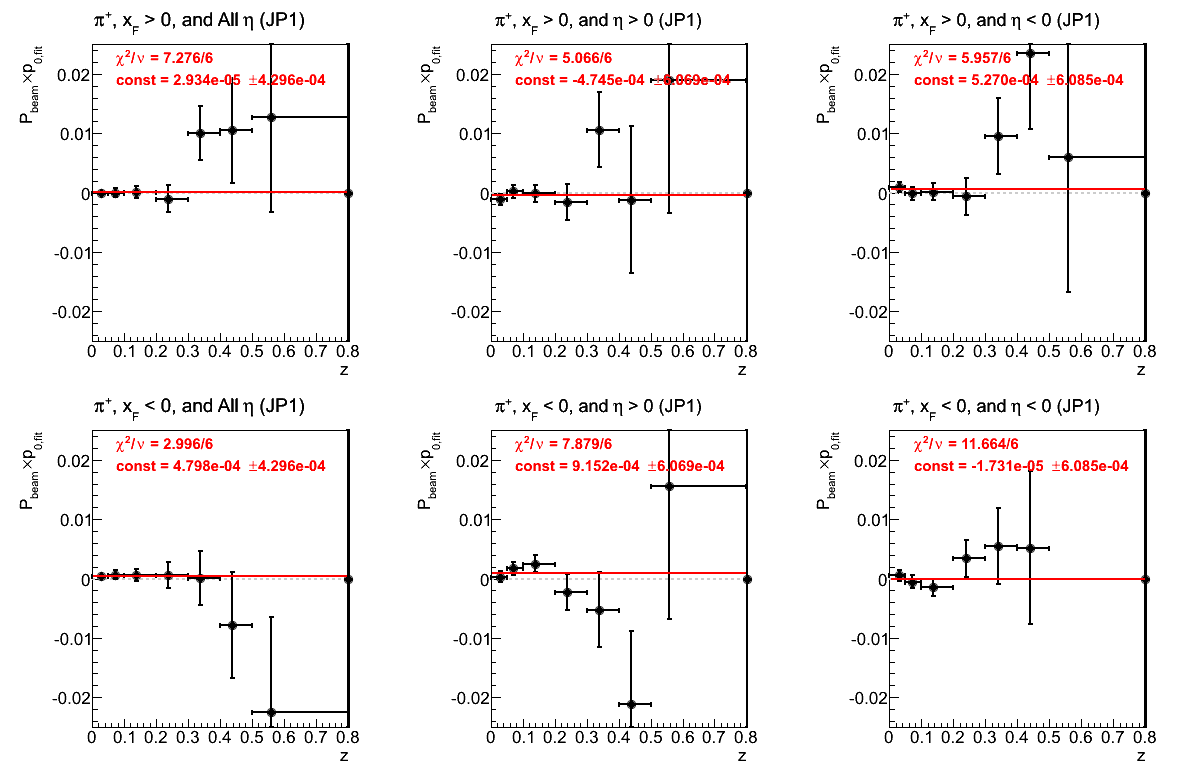
Figure 21: JP2 Triggers
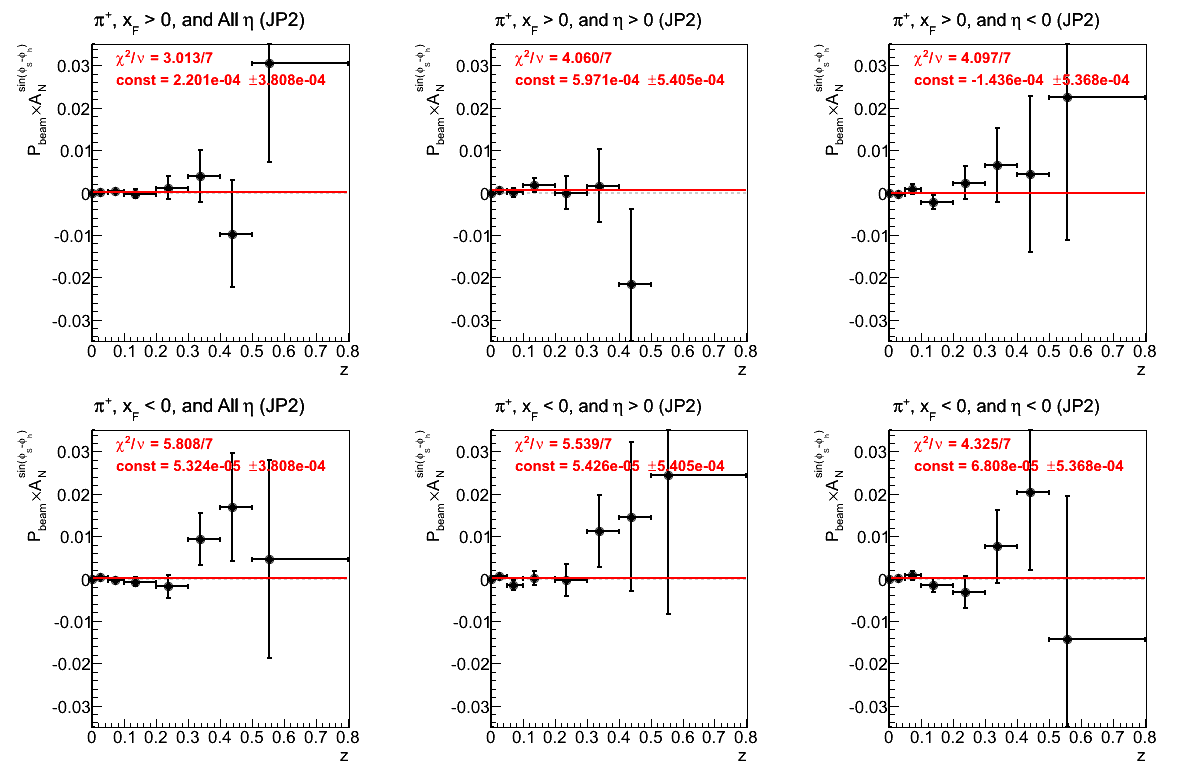
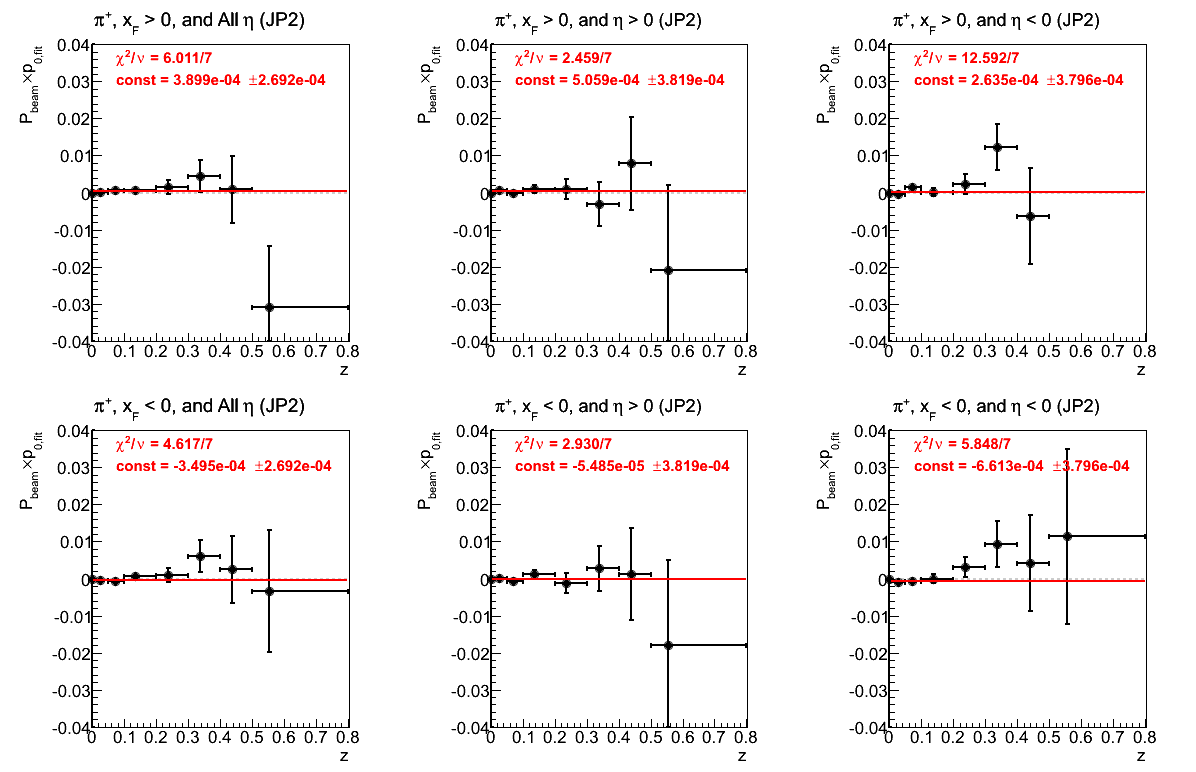
Figure 22: AJP Triggers
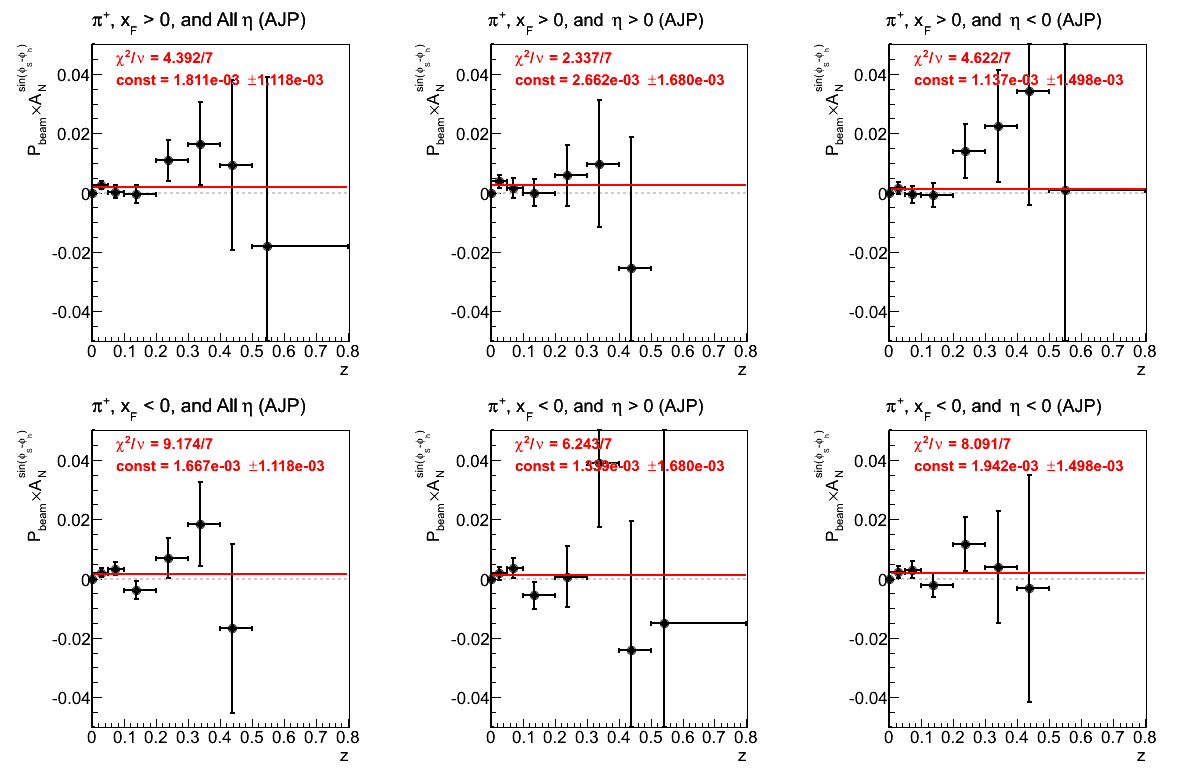
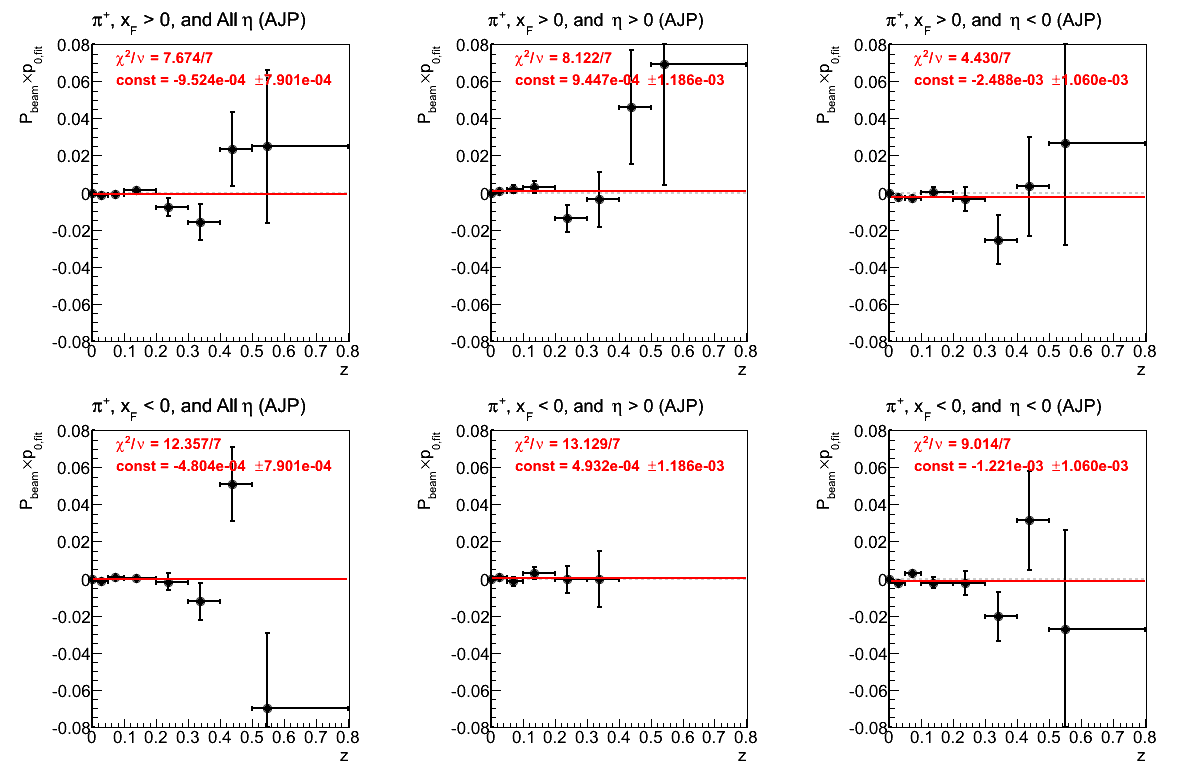
Figure 23: VPDMB Triggers
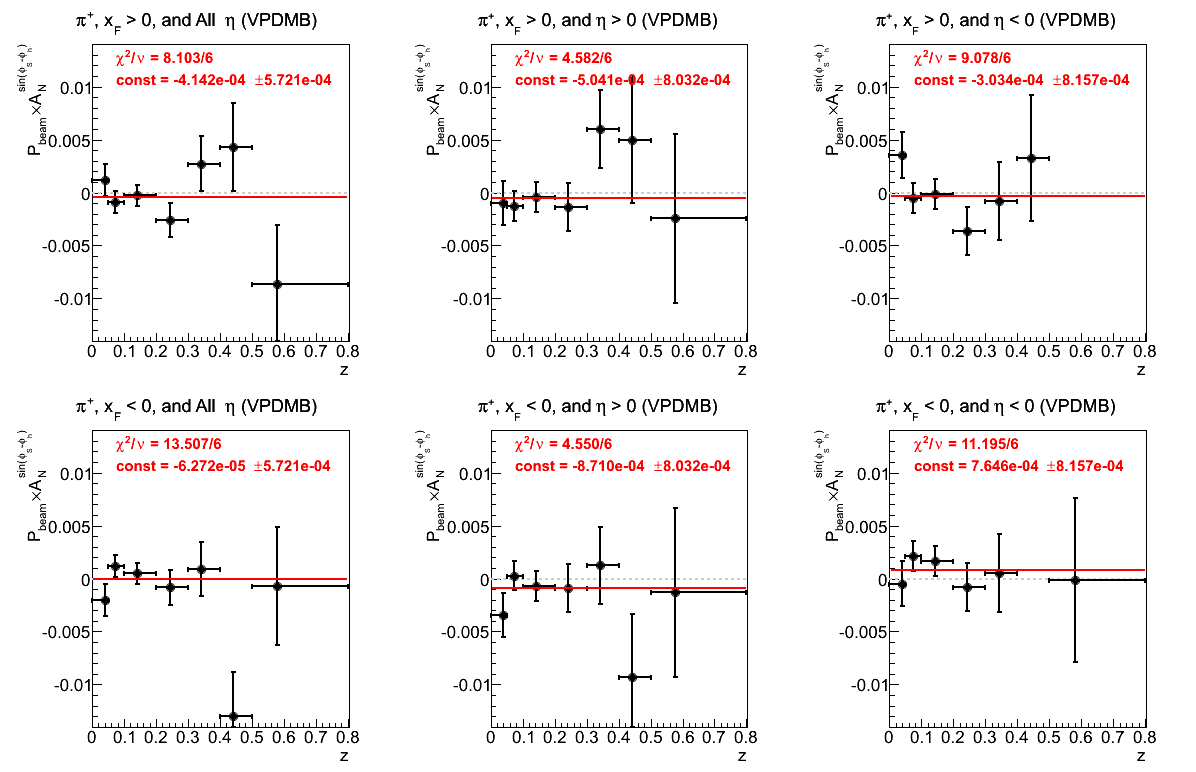
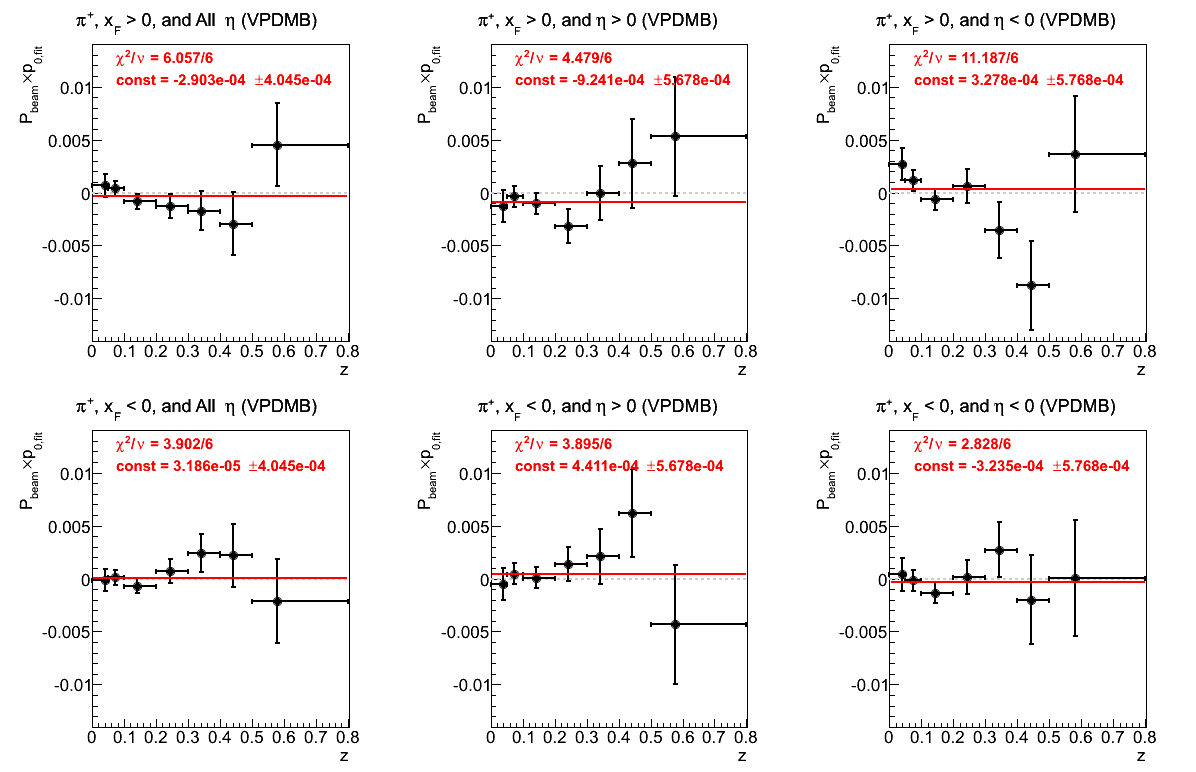
π-
Figure 24: JP0 Triggers
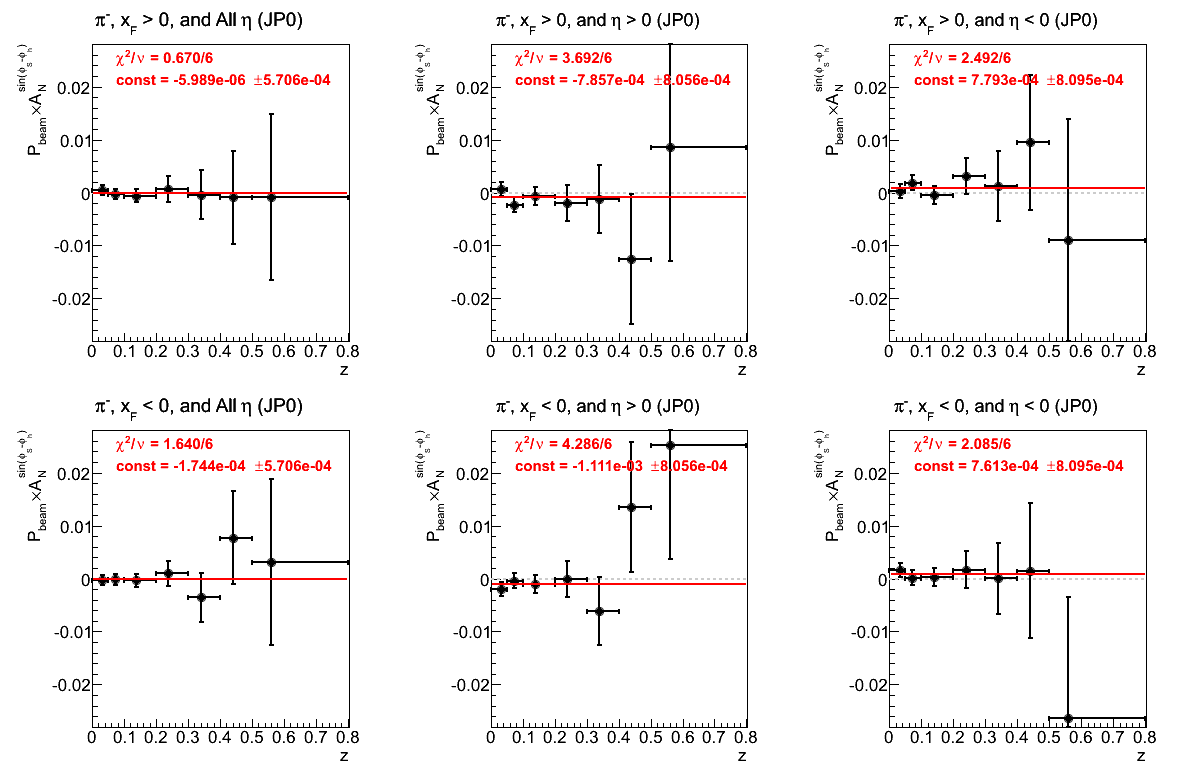
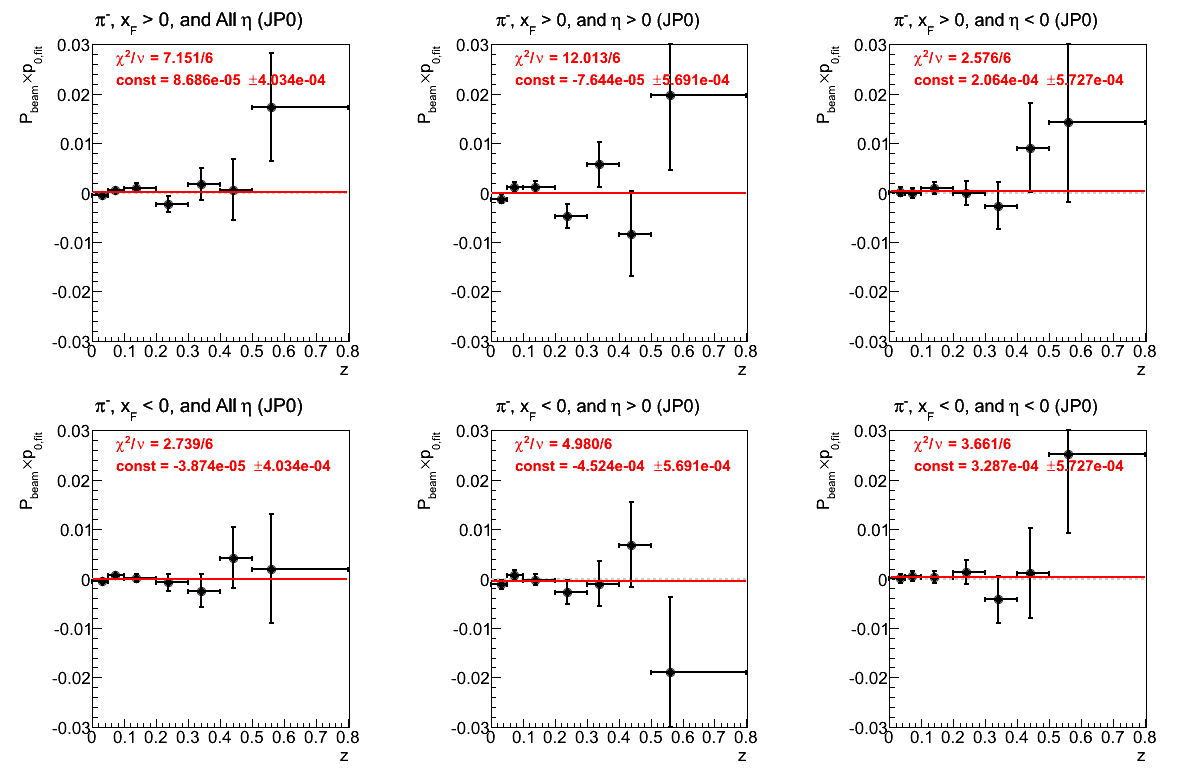
Figure 25: JP1 Triggers

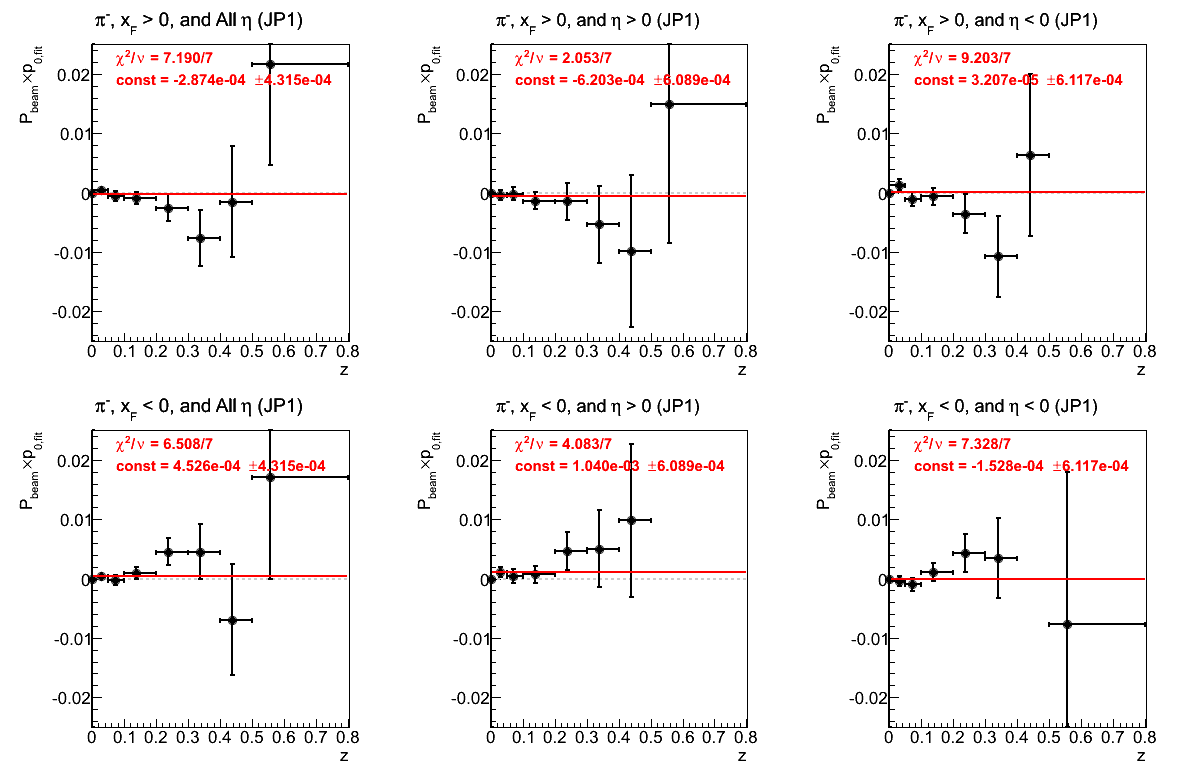
Figure 26: JP2 Triggers


Figure 27: AJP Triggers
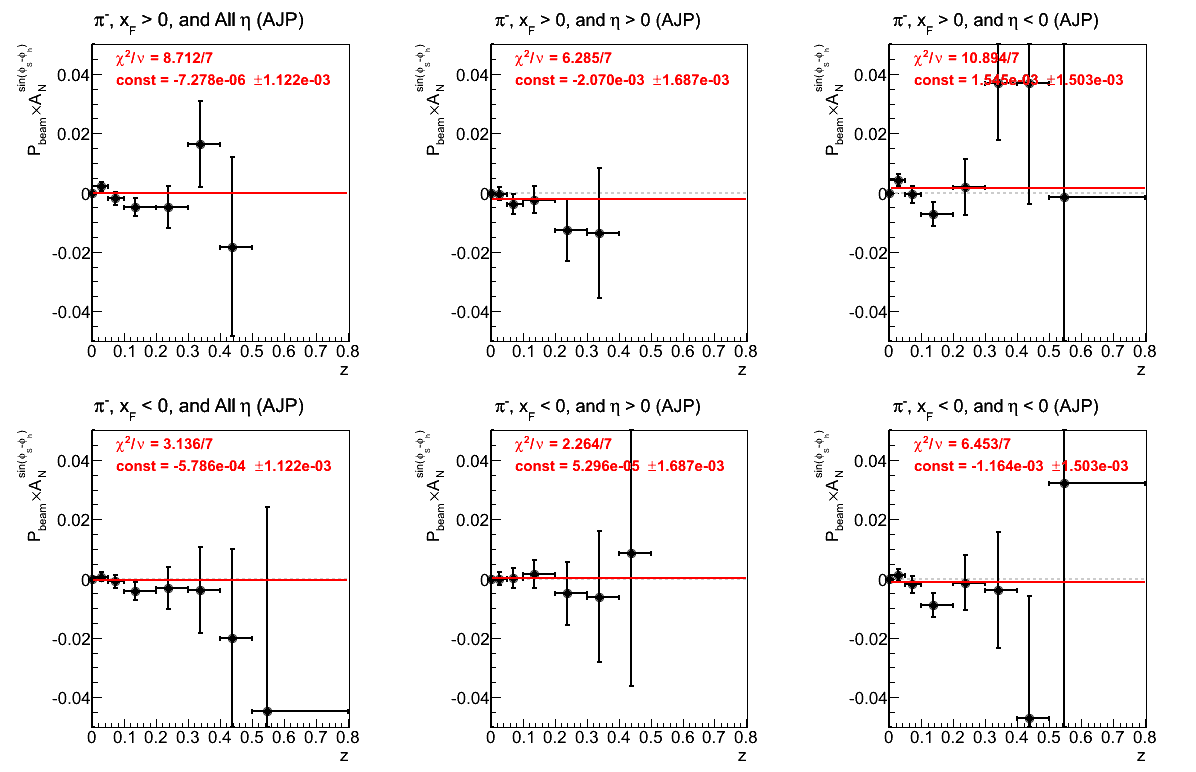

Figure 28: VPDMB Triggers
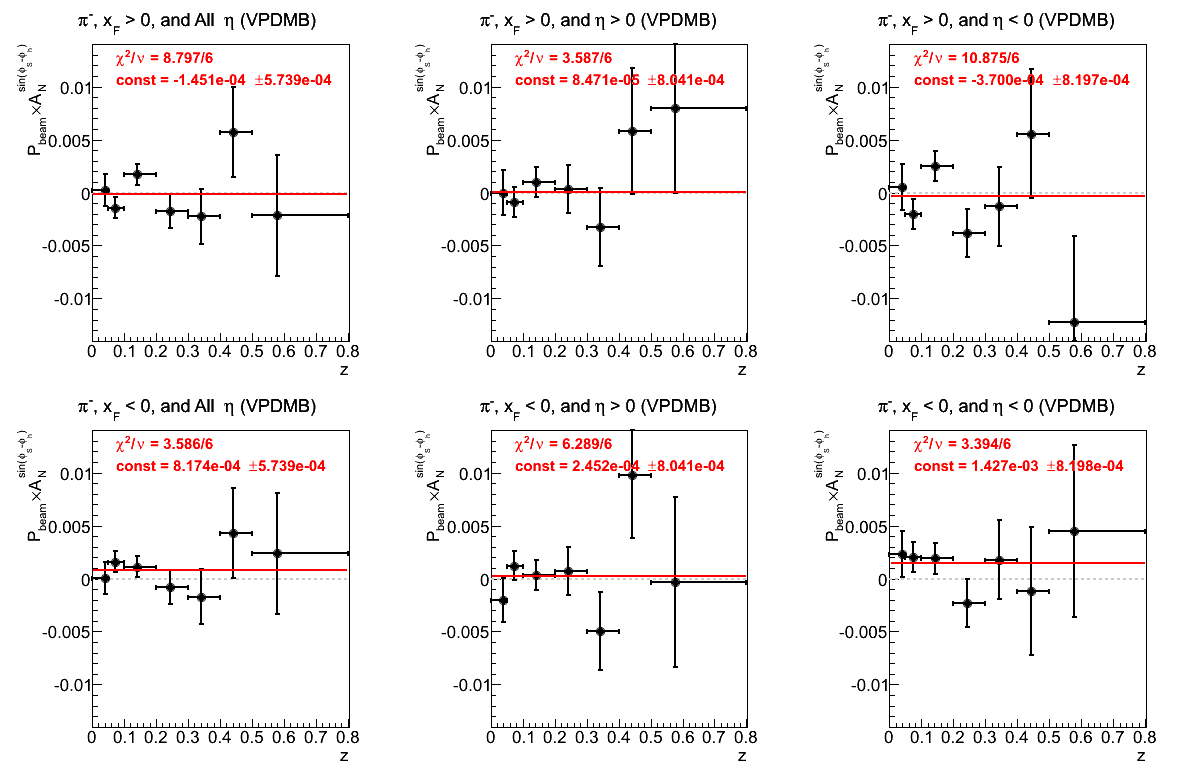

- drach09's blog
- Login or register to post comments
